Clipper Pale: circa 1940
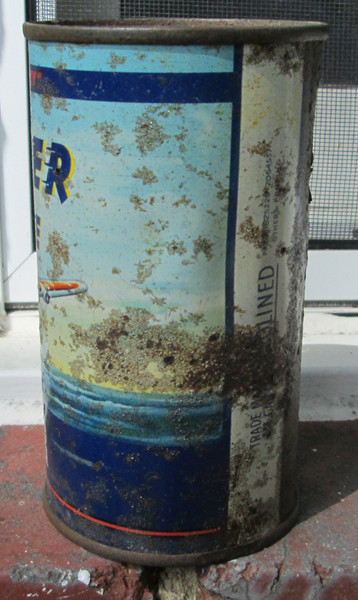 |
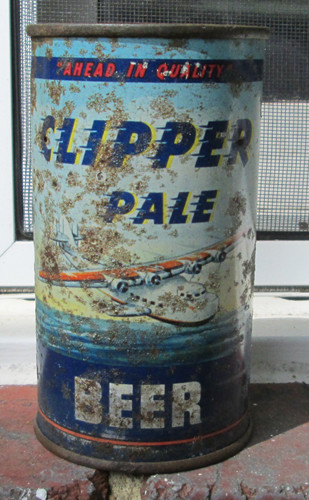 |
 |
Grace Brothers Brewing
Grace Brothers Brewing was in business from 1897-1920 and again after Prohibition from 1933 to 1966. They have a long (and somewhat confusing) history, as the extended Grace family bought and sold numerous breweries in the decades after Prohibition. The family began brewing in 1897 when grocers Frank and Joseph Grace bought the Santa Rosa Steam Brewery. They made lager and steam beer which was sold in bottles and barrels to local saloons, and to the public in bottles and large buckets called "growlers." The brewery survived the 1906 earthquake that leveled much of neighboring San Francisco. Their in-house horse-drawn fire-fighting equipment was used to help put out the many fires that devastated the area. The brewery closed in December 1918, following government orders to preserve grain and fuel at the end of the First World War. It would not open again until Prohibition ended in 1933.Grace Brothers opened again in the Spring of 1933 and in early 1936 began selling beer in cans, selling such brands as Nu Deal, GB, Cremo, Excell and Monogram, which today are tough cans for collectors to find. In 1937, Joseph Grace and several nephews bought the Rio Brewing Company in Los Angeles and renamed it Grace Brothers Ltd of Los Angeles. The Grace Brothers Ltd. brewery sold beer in southern California while the Santa Rosa-based Grace Brothers Brewing sold beer in the northern part of the state. Both Grace Brothers, and Grace Brothers Ltd. made Clipper Pale.
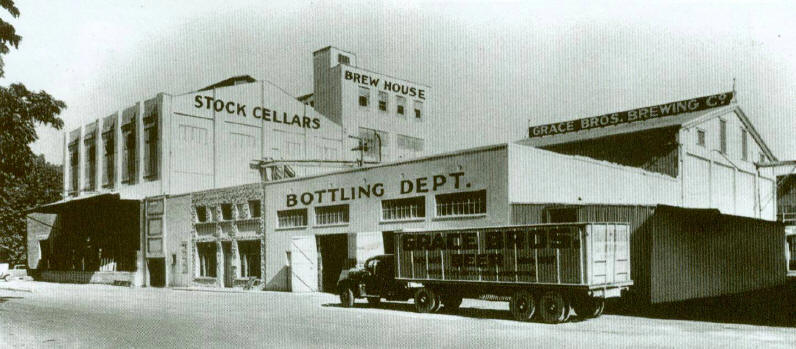
Grace Brothers Santa Rosa brewery.
The China Clipper: 1935-1941
Picture courtesy of www.aviation-history.com. This is the Martin M-130.
The Clipper Pale shows the Pan Am clipper, which was a flying boat: it took off from, and landed in, water. They first started passenger service in 1934 flying between Miami and Buenos Aires. The China Clipper started service in 1935. Based on Treasure Island in San Francisco Bay, the China Clippers flew from Honolulu to Midway, then on to Wake, Guam, Manila, and Macau.
While Pan Am's fleet of flying boats generally came to be known as Clippers, there were actually three different models of aircraft: the Sikorsky S-42, the Martin M-130, and the Boeing 314. Pan Am founder Juan Trippe strove to give passengers a traveling experience rivaling the comforts of a luxury ocean liner. Passengers enjoyed the finest food, drink and amenities, but in today's dollars a ticket across the Pacific aboard a Pan Am Clipper would cost $10,000. There were sleeping quarters, but passengers could also sleep ashore overnight in a local hotel during stops.
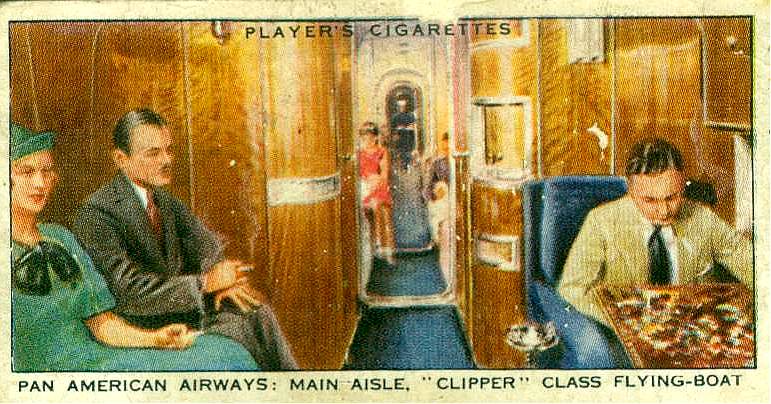 Inside of a Pan Am Clipper. From an English cigarette card of the 1930s.
Inside of a Pan Am Clipper. From an English cigarette card of the 1930s.
Coming up with the name "Clipper" was a logical choice for Trippe. His family had amassed their fortune in the 19th Century on Clipper ships which sailed between the US and China. Like his forebearers Trippe also took advantage of using the sea for trade so as to work around the lack of concrete runways, which at the time were expensive, and therefore rare, in the Pacific and East Asia. Equipped with giant pontoons, his flying boats were able to take off and land on water and so like their maritime namesakes, the Clippers made use of the oceans to form a vast global network of air routes.
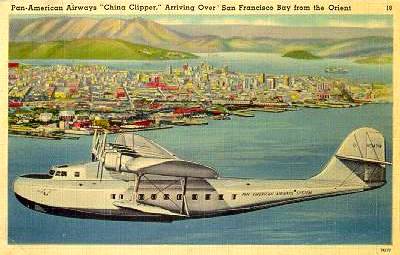 China Clipper arriving in San Francisco.
China Clipper arriving in San Francisco.
The first Pan Am Clipper introduced was the Sikorsky S-42. Launched in August 1934, the S-42 first began service in Pan Am's six-day Miami to Buenos Aires route. Carrying up to 32 passengers the plane was limited by a 1,200 mile range which could only be stretched with help from additional fuel tanks.
To make the longer distances, Pan Am introduced the second version of the Clipper, the Martin M-130. Launched with much fanfare, the first M-130, named the China Clipper, first flew across the Pacific in late 1935. The following year it offered passenger service on the over 8,000 mile, week-long trip to Hong Kong ( a trip which took over two weeks on a ship). Three M-130's were put into service, each carrying between five to eight crew members and as many as 46 passengers.
The third and largest of Pan Am's flying boats was the Boeing 314, which entered service in 1939. It was the largest commercial aircraft ever used until the 747 entered service 30 years later. The 314 could carry up to 74 passengers during day flights while offering sleeping accommodations for up to 36 passengers. The 314 - as well as the other Clippers - was divided into several luxurious cabin compartments including a stateroom, dressing rooms, and men's and women's restrooms. It also had a separate dining room where passengers were served full-course meals. The Boeing 314 began Pacific service in early 1939, and a trans-Atlantic route later that year.
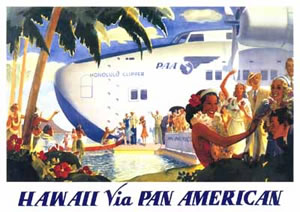
Travel poster advertising Pan Am's China Clipper.
With America's entry into World War II, Pan Am's fleet of Clippers was quickly put into military service. The planes' long-distance range combined with a tremendous storage capacity proved valuable during the war. When the war ended, worldwide expansion of airports with new and improved concrete runways led to the Clipper fleet's ultimate demise. However, while the Pan Am Clipper fleet numbered only 28 - thirteen Sikorskys, three Martins and twelve Boeings - they came to symbolize the height of globe-trotting luxury during the golden age of aviation.

The Yankee Clipper which crossed the Atlantic. Photo from the October 1939 Brewers Digest.
The Movies
There was a movie made in 1936 titled the "China Clipper" starring Pat O'Brien, Ross Alexander, Beverly Roberts, Humphrey Bogart, Marie Wilson, Henry B. Walthall, Joseph Crehan, and Joseph King. The plot? "Inspired by Lindbergh's flight, Dave Logan sets out with a Washington-Philadelphia airline but suffers financial problems. With flying ace Hap Stuart {Bogart} he tries clipper ships on the Caribbean, then aims for the trans-Pacific route. His relentless ambition forces those closest to him to abandon him." (Review quote from the Internet Movie Database.)
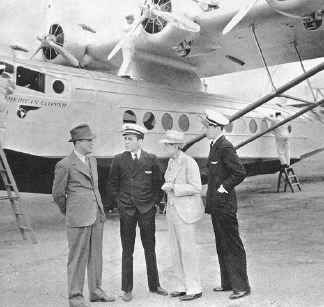
Humphrey Bogart in China Clipper, 1936.
Photo courtesy of bogart-tribute.net
Sources Used:
Beer Can Collectors of America. United States Beer Cans (Beer Can Collectors of America: Fenton, Mo) 39.
Brewers Digest. October 1939.
Burton, John C. "Two Brothers Think Big and Create a California Brewing Giant-Grace Brothers Brewing Company." American Breweriana July-August 2003 124:5-15.
Van Wieren, Dale P. American Breweries II (West Point, PA., East Coast Breweriana Association, 1995) 26, 42.
Thanks to John B. for the information!
Websites:
A good history website from a fan of the plane--nice graphics!
